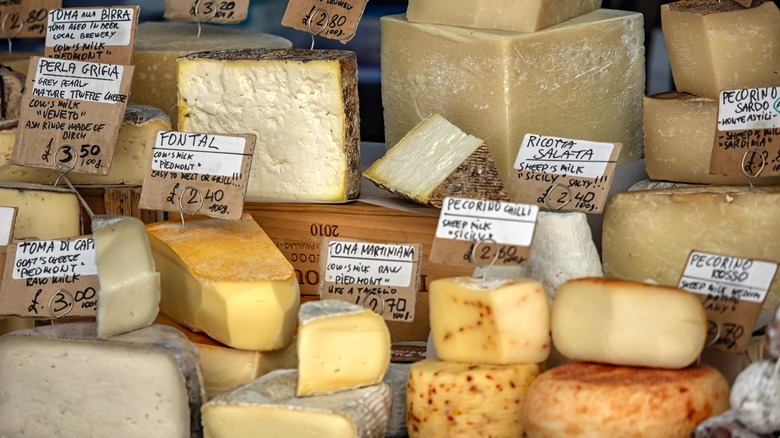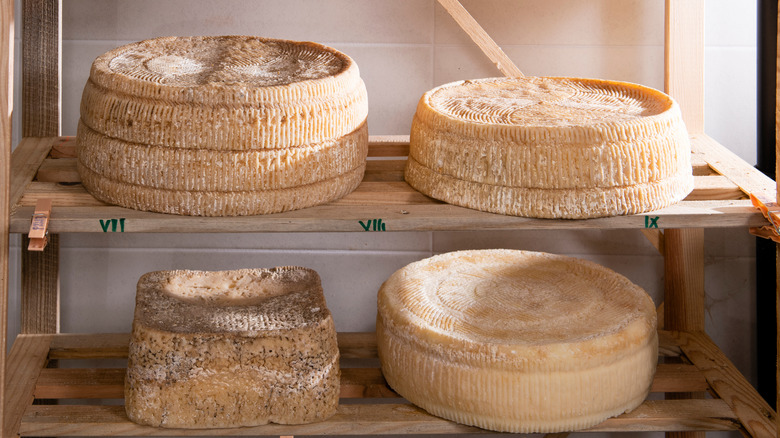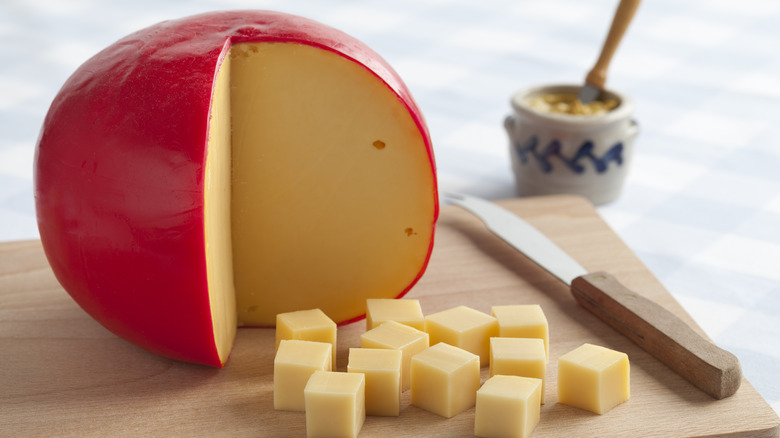The Cheese Rinds You Should Avoid Eating
You've been putting together a cheese board and you've mastered the art of arranging. It's table-ready and Instagram-worthy. But have you cut the right rinds off? Which ones should you leave? And when you're attending a party and you didn't make the cheese board, how do you know which rinds are and aren't edible?
Cheese rinds are there to protect the delicious insides of a cheese during the aging process. Some of them serve the purpose of imparting flavor or a different texture. Rinds fall into two and a half categories: "yummy, can eat" and "not yummy, can't eat." The extra quasi-category is "while edible, I don't find it appealing" — we give you our blessing to avoid eating these, as well. But how can you tell if eating the rind will win you concerned looks or if leaving it on your plate will make you look like either a picky or unknowing cheese eater?
Rinds you can and should eat
In truth, most cheese rinds are edible. This makes it pretty easy. As former executive director of the Vermont Cheese Council Tom Bivins told Food & Wine, "Just taste a little bit, you'll be fine. The cultures are good for your gut health and they aren't going to hurt you. No cheesemaker would put anything on the cheese that would be harmful." So that's good news.
There are three kinds of edible rinds: washed, bloomy, and — on a technicality — thick, natural rinds. Bloomy rinds are naturally formed from beneficial molds and yeasts, often white and floury-seeming, and found on softer cheeses like Brie and Camembert. They tend to have a slight astringent bitterness, balancing out the creamy sweetness of the interior.
Washed rinds can be flavored or unflavored. The basic washed rind is a brine rinse, sometimes with added cultures that can provide a slightly salty, reddish-orange exterior. Washed rinds can also be made with cider, beer, wine, port, coffee, or other liquid rinses to impart flavor to the cheese. These are absolutely meant to be eaten. Italian Taleggio is one example.
The third kind is a natural rind — generally hard but technically edible, like on wheels of Stilton or Parmesan. Though you might not want to chomp into some at a party, leftover Parm rinds don't need to go to waste: added to a soup or sauce, they impart a nutty umami layer, and put into the microwave, they become cheese puffs.
Rinds you can't and shouldn't eat
The rinds that are 100% inedible are the manmade kinds, like wax. Wax rinds block moisture evaporation, allowing the cheese to maintain a moist interior while preventing mold growth during the aging process. These rinds are found on cheeses like some goudas, wax-dipped cheddars, Edam, Airedale, most manchego cheeses, and many Derby cheeses. Some are thick, bright, and obvious, whereas others like manchego can be tricky. If there's a pattern stamped into the rind or if there's paper adhered to it, this can be a good clue that it's waxed.
Cloth is in this category as well, like on a clothbound cheddar. This allows the cheese to breathe as it ages and results in a slightly crumbly, drier texture. The cloth should be removed before eating the cheese.
Mont d'Or style cheeses are spongy and free-standing when they're young, but get soft and oozing when ripened — and, traditionally, come wrapped in strips of tree bark. "The bark becomes a very important part of the structure of the cheese itself," Jasper Hill's Molly Browne told Culture Cheese Magazine. Depending on the bark used and particular solution of cheese yeasts and molds it's soaked in, the cheese takes on flavors like pine, mustard, or smoked ham. The bark itself, though is in the "not yummy, can't eat" category.
For the most part, the rule is that if you don't like it or you know for sure it's not food, don't eat it. Otherwise, enjoy!


